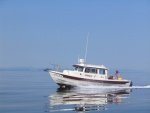South of Heaven
New member
I was in a scary spot today. I was in the Cape Cod Canal heading east (the area in question can be likened to an inlet or river mouth for example). Narrow opening and lots of water rushing out. The winds , current and Hunter Moon tides were all working against me.
It was bad. I would estimate the seas at 4 to 6 feet or more and closely spaced. There was no space to "recover". I had water come over the bow for a few waves and I lost the horizon too. I made it through, it was probably about an 1/8th of a mile then it was essentially flat after that! Crazy. I was definitely scared and was mentally preparing for the worst. I had my hydrostatic auto pfd on. I don't think my previous 19 foot boat would have made it through those conditions....
What would you guys do in that situation? Turn around? I was actually gonna turn around but was scared that a 6 footer would hit me on the side and roll me. This was a definite learning experience and eye opener for me. Im buying a ditch bag, small life raft and EPIRB (among other safety items too).The life raft wouldnt have done sh*t for me but a easily reachable ditch bag with the essentials could be very important. I do have a portable, waterproof VHF radio so I dont need that.
The craziest thing is that this was all within a couple hundred yards of land. Jeez
It was bad. I would estimate the seas at 4 to 6 feet or more and closely spaced. There was no space to "recover". I had water come over the bow for a few waves and I lost the horizon too. I made it through, it was probably about an 1/8th of a mile then it was essentially flat after that! Crazy. I was definitely scared and was mentally preparing for the worst. I had my hydrostatic auto pfd on. I don't think my previous 19 foot boat would have made it through those conditions....
What would you guys do in that situation? Turn around? I was actually gonna turn around but was scared that a 6 footer would hit me on the side and roll me. This was a definite learning experience and eye opener for me. Im buying a ditch bag, small life raft and EPIRB (among other safety items too).The life raft wouldnt have done sh*t for me but a easily reachable ditch bag with the essentials could be very important. I do have a portable, waterproof VHF radio so I dont need that.
The craziest thing is that this was all within a couple hundred yards of land. Jeez

